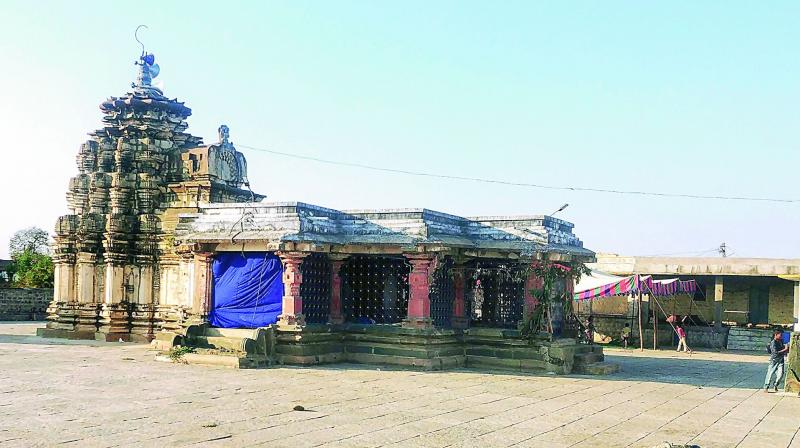Ramalingeswara Temple: This small temple is big on grandeur

Hyderabad: Good roads lead to the clean little village of Nandikandi, situated at a little distance from the village of Kandi, where Hyderabad IIT is expanding. The village got its name from the huge Nandi statue (Lord Shiva’s devoted dwara palak). Nandikandi’s claim to fame is the small but gorgeous temple of Ramalingeswara, whose main deity is Lord Shiva. A brass lingam sits on a beautiful, tall star-shaped granite pillar. The temple too is uniquely star shaped and was built in the 11th century. A large stone in the temple has some of its history inscribed on it and dates back to 1086. The hereditary priest of the temple, Joshi Venkatrao, says that the temple was built at the time of the valiant Kalyan Chalukya. He is supposed to have donated the temple, a Veda Pathashala, promised to do nitya annadanam to all saints who travelled long distances to do darshanam of the temple, and is also said to have adopted the neighbouring village of Kovvur. All of this is inscribed on the large single block of stone. The temple is small and single-storeyed. The base of the temple is star shape and it is built to open up into a lotus shape. Temple priest Venkatrao Joshi says that the pillar was probably built in the 10th century while the entrance could have been built in the 11th century.
The temple is an example of the Kalyana Chalukya style of architecture, and according to archaeologists, this temple might have been built during the rule of Vikaramaditya V. in 1014 AD attributed to someone else earlier-make up your mind. The entrance arch has seven inverted lotuses on top called a toranam, with gaps between each inverted lotus. It is said that the rays of the morning sun filter through each of these gaps and fall directly on the Shivalingam in the sanctum of the temple. Each gap apparently represents a season. The rays fall into the sanctum sanctorum, lighting it up. It is the great good luck of the devotee who catches this phenomenon.
There are exquisite sculptures in every corner of the temple. The four pillars in the Central Hall form a mandapa or navaranga, as it is called. Students apparently visit the temple to understand the skill involved in its construction all those centuries ago. The pillars, each made of a single block of stone, are decorated with figures of the Hindu pantheon - Lords Brahma, Vishnu, Shiva, and Narasimha Swamy, Varaha Swamy, Nataraja Swamy, Devi Mahishasur Mardini, Devi Saraswati Mata and Gaja Lakshmi. Because both Shiva and Vishnu are represented, this becomes a Hari Hara Kshetra. In fact, one of the pillars is like a blueprint of the temple, with the design etched beautifully on one single pillar. There are also sculptures of dhikpalakas, (guardians of directions), beautiful women, demons etc. The sanctum sanctorum has been designed in the shape of a star, while the shikaram of the temple is designed like a lotus.
There is a four-foot tall statue of Lord Ganesha in the southern part of the sanctum. The other attraction is a humongous Nandi, carved out of black stone, quite the star of this temple. The temple is said to have been attacked by Muslim invaders and some of the statues bear the scars. The Ganesha statue has been repaired and painted, the Nandi too has been repaired but it still has a wounded look. There is a notation on one of the paws of the Nandi, which is presumed to be the name of the sculptor. “Our family has been priests for the past 700 years,” says Venkatrao Joshi, who is both temple priest and school teacher. He has no idea who the first priest was, but knows that he is a ninth generation priest for this temple. “We did not maintain a family tree and there are a lot of missing links,” he says. Though located on National Highway No 9 on the Mumbai route, this temple is not very well known. Since the priest also teaches, he finishes the prayers by 6.30 am; the evening puja is conducted only after 7 pm.
A tourist guest house was built nearby some two years ago but is still not in use. But a boundary wall has been built and the area around the temple has been paved to make walking easier. The temple is registered with the Endowments department, but that is in name alone. It is the villagers who help to run it. Small amounts are deposited in the hundi by those who believe that some of their wishes have been fulfilled. A curious fact about the village is that it has not a single potter or kumara family. The story goes that Lord Shiva had once been disturbed by the noise made by a potter family and so banished them forever from this village. A tall deepa stambham at the entrance of the temple is used to light the diya during Karthika Pournami night.

